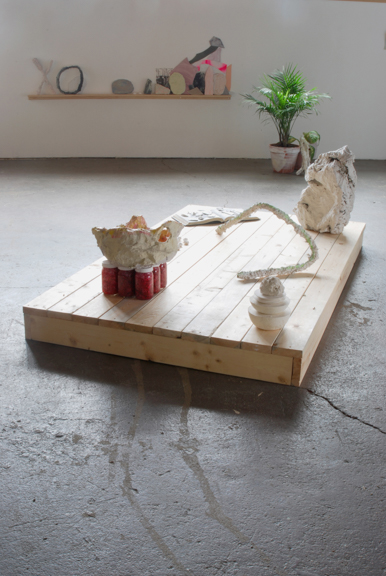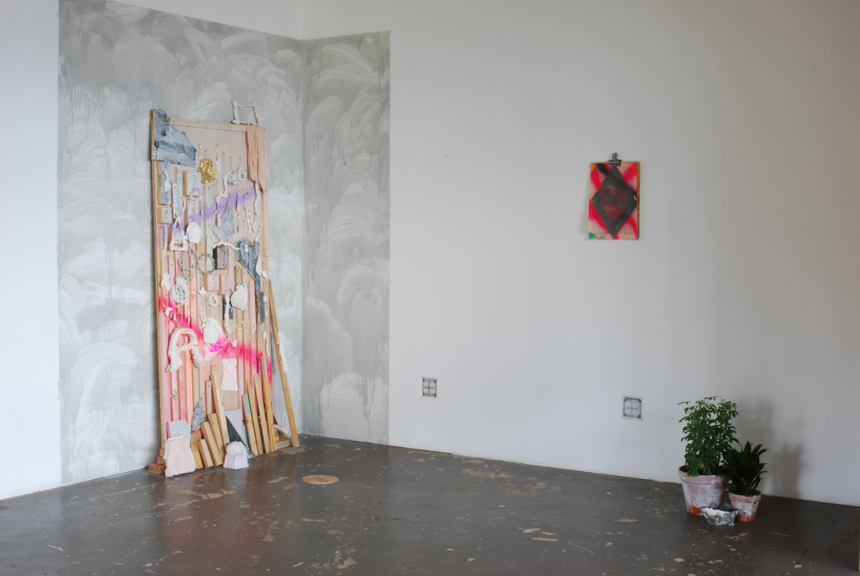Lauren Rice
Lauren Rice is an artist originally from Atlanta, GA. Rice received her MFA in Painting from American University in Washington, DC and her BA in Studio Art from Knox College in Galesburg Illinois. She has had solo and collaborative exhibitions in Detroit, Nashville, Washington, DC, New York City and Philadelphia. Her group exhibitions include Trash4Gold at The Spring/Break Art Show (New York, NY), Abstracticus at Passenger (Detroit, MI) Off the Wall, Mirus Gallery (San Francisco, CA), Miami University’s 2012 Young Painter’s Competition for the William and Dorothy Yeck Award, (Oxford, OH) and Art on Paper 2010 at the Weatherspoon Museum of Art (Greensboro, NC). Rice has been a fellow at The Kala Art Institute in Berkeley, CA and her has been published in New American Paintings, edition 118. Rice recently relocated from Detroit, MI to Richmond, VA where she is an Assistant Professor of Art at Longwood University.
Statement
In my individual practice, as well as in my collaborative practice with Brian Barr, I consider Western culture’s objects and images as ephemera from our historic moment. I imagine a world where today’s glut of images have become functionless artifacts within a deteriorating landscape. I create a vision of possible futures of objects and images. The crumple, the fold, the curl, the cut, the fragment, the erased, the cover up—all are means in which I visually compress, distort and recontextualize information. My studio practice is highly experimental as I test new combinations of paintings, photographs, found materials and environments.
My installations explore a history of objects and images as well as the role of the maker and producer/consumer. Seeing myself as a collector engaged with the postproduction notion of recycling and reshaping images in order to reexamine history and by default, the future, I find and modify images, objects and structures. From self-help articles to Greek vases, whether examined for their aesthetic or functional value, I am interested in how these tools have provided, or will provide, information about specific instances in culture. Simultaneously sincere and cynical, I examine consumption and conservation, slow food and easy fixes, desire and guilt. Constantly categorizing and contextualizing, by creating networks of seemingly unrelated objects, I am referencing modes of indexing, archiving and recording.
In my paintings, I strive to depict imagined fragments from future and former languages (a sort of digitized cuneiform). These abstractions, often on paper, canvas and wood, contain elements of wear, such as folds, cuts and erasures, that serve as visual compressions of contemporary language, digital code, dead languages, and imagined languages of the future. Intentionally difficult to decipher, my work provides a contrast to an age of information, images and technology. Through my placements of parts, I intend to create a poetic future grammar, a foreign language from which we can find understandable fragments, but cannot construct a cohesive whole. These paintings are often combined with three-dimensional elements, found images and irregular systems of display to further confuse the distinction between image and object, actual and virtual.
Interview with Lauren Rice
Written by Sidney Mullis
You mention that your practice is highly experimental due to the many stagings that are possible when combining paintings, objects, photographs, etc. When do you know that a piece has reached a level of completion? Do you seek finality, or do you regularly recombine elements into future work?
Most of my work is never finished in the studio, but comes together in installation form in the gallery space. For me, standard notions of “finish” aren’t really important. The components in my installations aren’t static—after the end of one exhibition, they often play a role in another.
You mention that your work begins from a place where “today’s glut of images [and objects] have become functionless artifacts.” How did you come to frame your work with this mindset?
I lived in Detroit from 2008-2014. The visual presence of abandoned buildings and objects greatly affected my practice. I think that living in Detroit forced me to realize on a grand scale that the perception of an object, image, or concept can shift over time, becoming a “functionless artifact” in their changed environment. It is fascinating to me that it doesn’t take a very long time for an object or image to become dated, obsolete or indecipherable. I think the drastic changes in technology have also contributed to the speed at which this change occurs, as formats for sending, receiving, storing, and viewing data change.
How do the curled edges function in your paintings?
The function of the curl in my works on paper is twofold. First, I want the curl to reference a scroll or an archaic support for written and visual language. Secondly, I want to acknowledge the paper as a three-dimensional object, rather than a flat surface.
I really enjoy how you title your work. You name some of your pieces with titles of forward-thinking people or sage-like roles, such as Pythagoras, Pioneer, and Shaman. Do you think those titles have become obsolete in Western culture today? How do you think they will be reimagined in the future, if at all
Growing up, my mother always read me Norse mythology and fairy tales. Although I am not religious, I think my background fostered an interest in mythologies and stories that have been told throughout history in various cultures. I am also interested in the characters that have shaped the way we frame aspects of our world and how we look for figures that can explain the unknown. I want to play on how, in this imagined future that I’ve constructed, one might project spiritual significance onto artifacts from our present.
Your installations often include a conspicuous potted plant or two. Could you talk about this inclusion?
I included living plants in my 2013 installation “Tools for Better Living”. For this show, I was exploring the so-called tools that we “need” to survive contemporary life in both a serious and humorous way. I was also interested in creating comparisons of various tools throughout history and my own imagined future(s). I was pretty open-ended with my use of the word tool, as I wanted to investigate a variety of objects and imagery that have occupied our world over time. I had used fake flowers and plants in my work in the past, so including living plants was a great way to experiment. I do think that plants are vital resources in home settings (my home is full of them!) and I was also really excited about how they became specimen-like the in the context of the gallery.
For me, the potted plant becomes a companion when looking at the work. While the paintings, objects, environments, and photos, compress and contort content of the past and future, the living plant and I seek our place within it all. Does this resonate with you at all?
Sure! I think that is an accurate read. The other components in my exhibitions usually stay frozen in space while the plant moves and changes, much like the viewer. I split a plant in two right before the opening of “Tools for Better Living” and both halves were included in the show. Over the course of the show, one half thrived, and the other wilted. I felt like it was pining for it’s other half from across the gallery space, referencing love and loss (human emotions which we often seek out “tools” to help us understand and process).
Can you describe your working routine? Do you have a daily studio practice?
I am a professor, so during the academic year I am usually in the studio 2-3 full days and a few short days each week. During the summer, I am in the studio as often as possible. Having a studio space outside of where I live has always been important to me, as I need a space where the distractions of daily life can fade. I usually have multiple projects going at once—I like to make a move on one piece and then give it time to rest as I work on something else. I also really like to make things without exactly knowing how or where they will end up. These components often sit in the studio for a while before their “home” becomes apparent.
Could you discuss your collaboration with Brian Barr? When did it start? How do your ideas coalesce? Where do they diverge?
Brian is my husband in addition to my collaborator. We started collaborating because we share a studio and are always discussing our work and our ideas. Finding a way to bring our work together seemed like a really intriguing challenge for us both to take on. Our ideas often overlap; we are both very interested in the potential future for ideas, objects and images and the ability to contextualize aesthetic moves. Brian tends to be more theoretical, whereas I am more poetic. Our practices are pretty dissimilar. Brian is a planner and tends to work towards a concept, and I am, first and foremost, a maker and I research/conceptualize during or after the process of making.
You have previous curatorial experience. How did you come to take on this role? Does this role affect your practice as an artist?
All of my curatorial projects to date have been co-curated with Brian. He has been curating exhibitions since 2009 at various galleries, universities and museums. We were interested in seeing how our different aesthetic and conceptual sensibilities would come together curatorially. I think curation was a logical step for us—it has allowed us to give artists’ we believe in the opportunity to create new projects, as well as to highlight work we find really relevant and exciting, to show emerging artists alongside those that are becoming more nationally recognized. I do think the process of curating has affected my practice—the arrangement of parts, and the creation of relationships between these parts, has become an increasingly important aspect of my work.
You have maintained a fruitful career for many years. How do you sustain a creative and full life as a maker? Any advice for newcomers or the recently graduated?
This is such a good question and a difficult one to answer! For me, it is crucial to be fearless. Experimenting in the studio is really important. I ruin many pieces, and that is a part of my process (and sometimes the so-called ruined pieces become the most interesting!). There are also so many other things, outside of the studio, that fulfill my practice—relationships with other people, reading, cooking, teaching, traveling, looking. As far as advice goes, work hard!
Any new projects or upcoming exhibitions you’d like to share with us?
I currently have a solo show, “Former Self and a Bright Future”, up at Hatch, a gallery in Hamtramck, MI. I will have a collaborative show with Brian at Purdue University in January and a solo show at The Arlington Arts Center in April 2016.
Thank you for taking the time to share your work and chat with us!
To find out more about Lauren and her work, check out her website.











